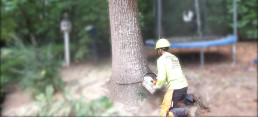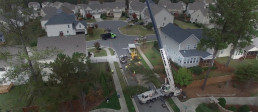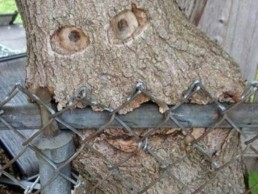Each tree removal that we perform is different. Every tree possesses a unique set of circumstances and conditions that makes it different from every other tree removal. Location, size, proximity to surrounding structures, branching formation and so many other things come into play when removing a tree. While just about anyone can cut a tree down that is in the middle of a field. It takes a skilled, trained and experienced professional to safely remove trees from the urban environment. Our teams of certified arborists and tree climbers possess the necessary experience training and skills to safely and efficiently remove your unwanted and hazardous trees.
We really, really take pride in what we do and we honestly love it. Tree removal takes a delicate combination of art, science engineering, brute strength, common sense and courage. For us, it goes farther than simply removing trees. We not only want to remove the tree, we want to be the best at removing it. The absolute best. It is our goal to leave your property better than we found it.
Please take a little time to review this page. The information below will help you understand the techniques and methods that we use to remove trees.

Felling the entire tree.
Felling an entire tree is the simplest tree removal method and it is quickest way to get the tree onto the ground. Before a tree can be cut, the person that is responsible for cutting must estimate its height. After the height of the tree has been determined the cutter will then check the area to verify that there is enough space to safely drop the entire tree. There is usually not enough space to safely drop an entire tree in most residential settings. Therefore, the tree must be climbed and taken apart in sections. If there is enough space the tree cutter must then estimate the amount of lean the tree has and the direction it is leaning. He will check for other factors such as branch distribution and symmetry. If there is more weight on one side or the other it will affect the trees once it has been cut. He will also look for any defects or problems in the trunk of the tree. Rotten sections or cavities could cause the notch to prematurely give way. Once this inspection has been completed the tree cutter will know where to aim the tree and what type of notch to use to best help him get it there. A rope will be attached to the tree prior to cutting. This will help the tree removal crew safely guide the tree during the cutting process.
Once the tree and site have been checked out and the rope has been securely attached to the tree, the tree removal process will commence. The person responsible for cutting the tree will make a notch also known as a wedge. A notch is used to direct the tree into the desired direction. Once the face of the notch has been made the tree removal expert will then make the final cut. Also known as the back cut. During the actual fall, the direction that the tree is falling can be changed a little. By cutting a little more on one side of the back cut and less on the other it will change the direction of fall by a few degrees.

Climbing the tree and cutting it in sections.
Climbing a tree and cutting it in sections is the most common tree removal process for removing unwanted trees that are in close proximity to structures, power lines and other obstacles. Just like every other tree removal it starts with evaluating the tree and site. Once that is complete the tree climber will develop a plan for removal. The best tree climbers like the ones we have here at Arbormax dismantle the whole tree in their mind before they ever put their climbing spikes on or start their saw. One of the most important things about planning a climb and tree removal is determining where your tie in points will be. Good limbs and crotches must be located to set the rigging from. After the tree climber has ascended the tree and set his rigging points up he will begin the cutting process. Each tree will require a different approach. Most trees will require the lowest limbs to be cut and lowered first and the highest limbs to be cut and lowered last. When all of the limbs are removed and only the trunk is left the tree climber will make the necessary cuts to safely get it onto the ground. If the site allows, the trunk will be cut into12-16 feet sections. These pieces are heavy and require strong rigging lines. When there are no objects of value such as manicured landscapes or lawns below we will drop these sections whole. If there is not enough room or if there is a valuable object below the pieces will be carefully lowered with ropes. Skilled grounds operations personnel are just as important as a tree climber when it comes to removing a tree safely. The tree climber is in charge of formulating the strategy and making the cut. But the tree limbs and large pieces of the trunk are completely under the ground man’s control once that cut has been made. Once the limb is cut, the rope man will allow it to fall freely for a split second and then he will slow the fall speed by gradually applying friction to the rope. This gradual slowdown reduces the load that on the rigging point. A specific target area is always designated as a landing zone for the logs and branches to be lowered into. Most often the landing zone is directly below the rigging point and just lowering the cut pieces is sufficient. Sometimes, there are obstacles directly below the tree and the landing area can be 40-50 feet away from the rig point. This is where the ground man’s skills shine. He has to time the swing rate and fall speed accurately enough to hit his target. If he holds onto the rope a moment too long or to little it could have serious consequences. Property damage, personal injury and even death. Never let an untrained person climb or cut a tree for you.

Tree removal with a crane
This is without a doubt the best way to remove unwanted trees. It is the most up to date, cost effective, and efficient way to remove trees. It is also what has made us an award winning nationally recognized tree service. We absolutely love using our company owned cranes to effortlessly remove trees. We can maneuver enormous pieces of trees through the air with ease. To put it simply, tree removal with a crane is Awesome! The process starts by locating a place to stage the crane. The location and all of the options are discussed with the client during the estimate and consultation. The area must have enough space to fit the 18 x 24 foot footprint of the stabilizers and it has to be somewhat level. It must also be within the safe operating radius of the trees. The size of the tree to be removed plays a role in determining the safe operating radius. When the booms of our cranes are fully extended with the jib they have approximately 165 ft. of stick. This is about the height of a 15 story building. Height plays a role in the operating radius but isn’t our main concern. Distance is the main determining factor for a safe operating radius. The farther you reach away from the crane the less you can pick up. Our safe operating radius is up to 90 ft for most medium sized trees like Pines and sweetgums. We can go 135 foot away from the crane for smaller trees. Once the crane is set up and leveled the operator will telescope the boom out and put it in place over the tree. He will then lower the crane ball to the climber who is waiting at the base of the tree. The tree climber will then secure his safety line to the crane ball. The tree climber will then signal the operator to lift him into the top of the tree. After the climber has reached the top he will attach a special rigging sling to the tree and then connect it to the crane ball. Once this is done he will tell the crane operator to apply tension. The tree climber will then descend down the tree on his rope to a predetermined spot and secure himself to the tree. After securing himself and check all of the surroundings he will signal the crane operator and begin his cut. The crane operator will monitor the section of the tree for movement. When he determines that the piece has been cut all the way though he will lift it up and swing it to the landing zone. Once in the piece is in the landing zone the rigging will be disconnected by the ground crew. The crane operator will then swing back around to the tree and maneuver the ball to the climber so he can hook the next piece. This process will be repeated until the entire tree has been removed please visit our Crane assisted tree removal page for more info.

Ground operations and debris removal
The above three tree removal methods are ways of getting the tree onto the ground. What happens when it gets to the ground? That’s when the magic happens. That’s when the hardest working men you have ever seen go to work. Our ground operations crews have been compared to an army termites with chainsaws and bionic beavers. Their work is often compared to that of a well oiled machine, where everything is in sync. They have been known to dismantle entire pine trees in the blink of an eye. These guys really know what to do when the wood hits the ground. We recycle or reuse everything we cut. 100% no exceptions. Like clock work the ground crew will cut everything to spec so that it can be placed on the right truck. All limbs, branches and trunks under 12 inches will be fed through the wood chipper and turned into usable mulch. All wood over ten inches in diameter will be cut into specific lengths for logs. The logs are then delivered to various mills to be turned into products like paper, lumber and furniture. Once all of the large pieces of the tree have been removed the crew will then rake and blow the yard. Our crews are known to leave the yard cleaner than they found it.

Trees Can Be Monsters
Below are typical reasons for removing trees. Call us for a free consultation.
Dead Tree
Upon finding a dead tree you should have it removed as soon as possible. The longer you wait to take a dead tree down the more dangerous it becomes. Dead trees that are left standing too long can become unstable and will be unable to be climbed. This will require specialty equipment, which will increase the tree removal cost substantially. Some signs that your tree is dead are.
- An absence of leaves when there should be leaves.
- Sections of bark are separating from the trunk.
- Large limbs falling from tree.
Sick or Dying or trees
Sick or dying trees should be diagnosed by an arborist as soon as signs occur. If the tree cannot be saved it should be removed as soon as possible. Waiting will only make the tree more dangerous and difficult to remove which will also increase the cost of removal. Some signs that you have a dying tree include.
- Bare branches throughout the tree.
- Leaves turning brown
- Falling limbs
Structurally compromised trees
- Many things that can lead to a trees structural instability. Some of the following issues could warrant the removal of a tree and you should be on the lookout for them.
- Vertical or lateral cracks in the trunk of the tree
- Cavities in the trunk from old pruning wounds
- Rotting or decaying roots
- Various diseases that cause abnormal growth patterns ex. (fusi-form Rust)
Aesthetically Challenged trees
In some instances we do have to remove a tree just because it is ugly. Remember one mans beast is another mans beauty and landscapes require diversity to be complete. Not all ugly trees should be removed, but if you have you just can’t bare to look at anymore. Call us out and we will cut it down for you.
Overcrowding trees or landscape area
When in completion with each other sometimes trees will not grow at their full potential. This doesn’t necessarily mean that you should cut down all the trees in the yard so your 1 tulip poplar can develop. This is where our arborists come into play. We will gladly come out and explain in detail which trees should be removed or pruned so others can develop.
Landscape plans
Tree removal is often incorporated into new landscape designs making us the first step in a new landscape process. We work closely with landscape architects to ensure we meet all of the landscaping goals. Whether you are a landscape architect or a homeowner, if you are embarking on a new project we would be glad to help.
If the above reasons apply to you or if you have another situation that requires removing a tree we are the company for you. We have the expertise and equipment to handle any tree removal project no matter the size or circumstance.
